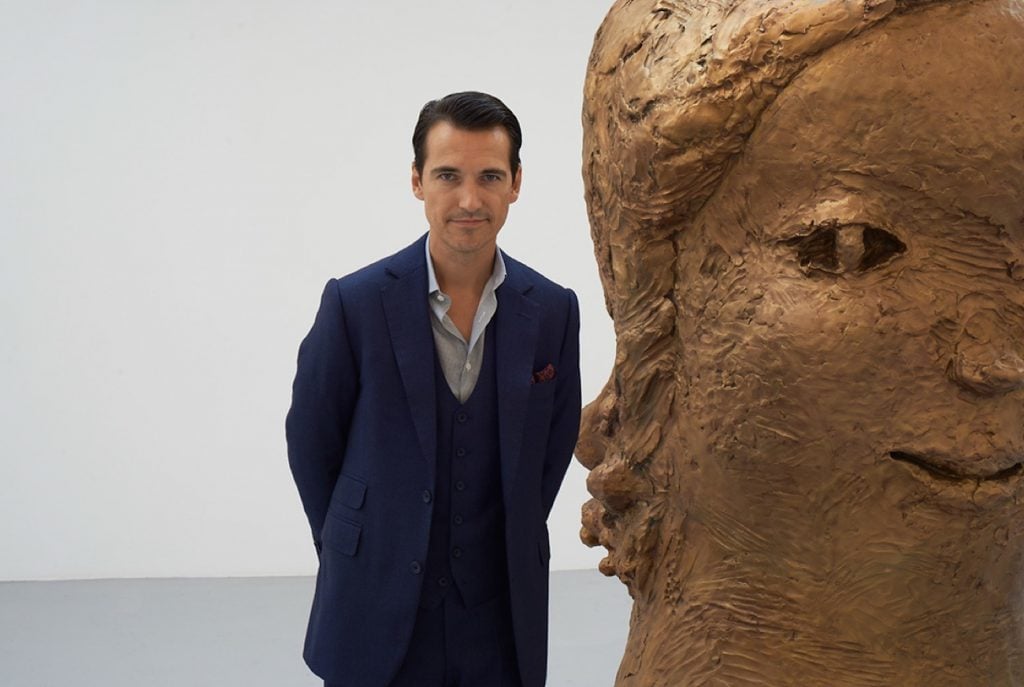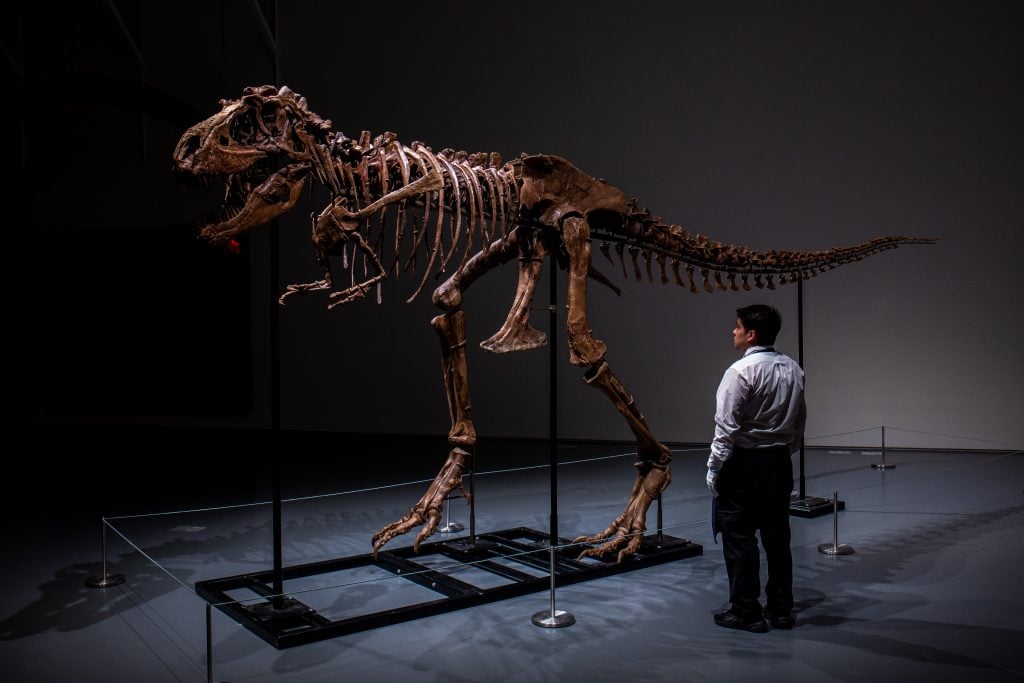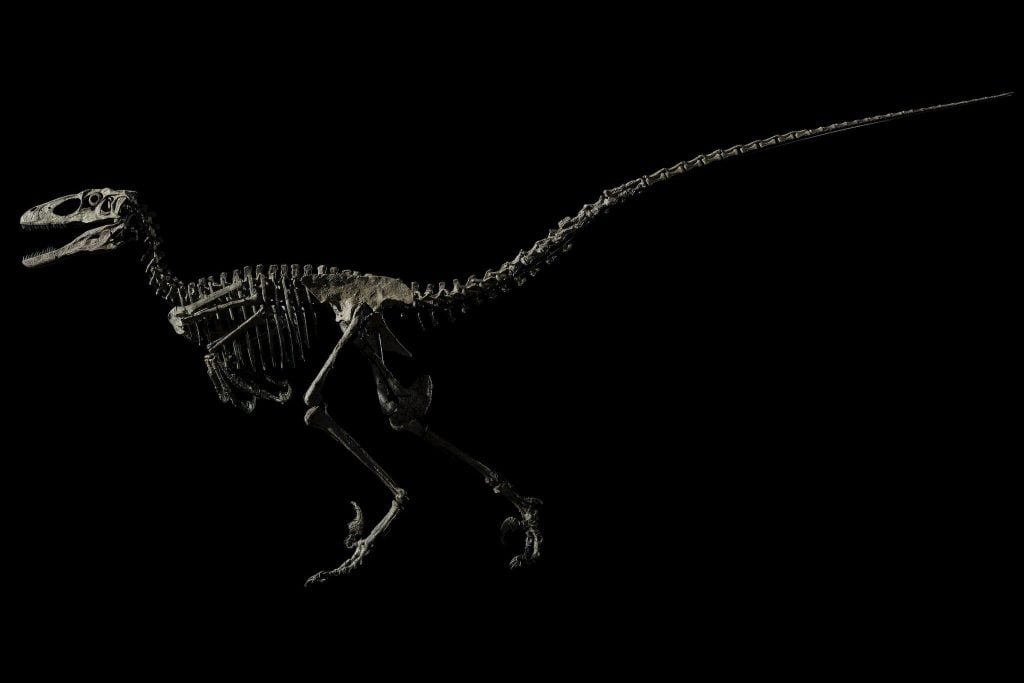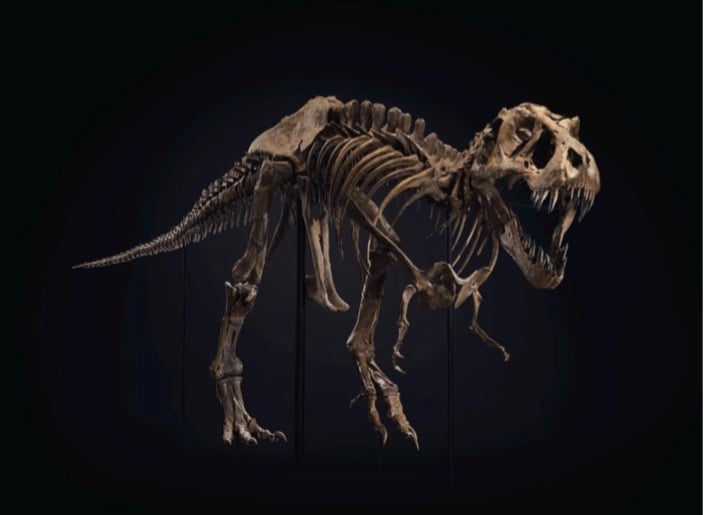Artnet News Pro
Why Are Art Investors Suddenly Ravenous for Dinosaurs? A Q&A With Nicolai Frahm, a Collector With Scientists on Speed Dial
The advisor shares what he has learned from a decade of collecting in the field.

The advisor shares what he has learned from a decade of collecting in the field.

Eileen Kinsella

In today’s art market, by the time you pick up on whispers about who is the next hottest artist to collect, their markets may have already fossilized. But what if they were fossilized to begin with?
A dedicated and growing contingent of the art world has found its newest obsession: dinosaur bones. If you haven’t been living under a meteorite you might have picked up on the trend. Late last month at Sotheby’s, a skeleton of a Gorgosaurus, a relative of the T-Rex that stalked the Earth roughly 80 million years ago, sold for $6.1 million. Before that, the grand finale of Christie’s marquee 20th-century evening sale in fall 2020—was the smashing success of a T-Rex skeleton named “Stan.”
Why was a 67 million-year-old skeleton included in a contemporary art sale? There is no one better to ask about this than Nicolai Frahm, the London-based art advisor behind it all. A co-founder of Frahm & Frahm, which specializes in producing large-scale institutional exhibitions, and collaborations with major contemporary artists, Frahm advises Christie’s among others in the contemporary realm, and was cited as one of the most influential people in London by the Evening Standard.
Frahm has been deep into dinosaurs for more than a decade, and it was his idea to include Stan in the contemporary sale. He recently consigned a rare skeleton of a raptor that inspired the villains of Jurassic Park, to another 20th-century sale at Christie’s. (It sold for $12.4 million). We spoke to him about the why of it all.

A Gorgosaurus Skeleton measuring 10 feet tall (3.04 meters) is unveiled at Sothebys in New York.
How and when did you get interested in this field of collecting?
About ten years ago one of my best and oldest friends from boarding school in Denmark bought a T-Rex skull and we were discussing how incredible it would be to actually build a collection of dinosaurs. At the time no one was doing it at scale, I think because people assumed that only museums could buy these things, and it was also a very different time.
My main focus is contemporary but I just love the dialogue between the dinosaurs and the art. It’s just so damn cool. I started buying and put them next to the most incredible artwork. It just functions so well that I view these almost as sculptures. I was thinking, why have a Jeff Koons balloon dog when you can have the T-rex for much less?
Every time I have an artist visiting me, they go completely bonkers at the dinosaurs. Historically, artists have always been obsessed with dinosaurs—Alexander Calder’s work references them. I gave Christie’s the idea of including Stan in the contemporary auction, and it sold for $31.8 million, breaking the previous record of about $12 million.
Who is this dinosaur-collecting friend? What is his name?
He’s very private. He has probably built the greatest private collection in the world—and mine is not too shabby either. Now the auction houses ask me for advice all the time. We’re in a very unique position because we are big collectors in this field. We get first call on anything new, fresh discoveries from the ground. That’s how I got the dinosaur that just sold. It was in the ground when they called. It was very unclear what it was, it’s very interesting to be involved in discovery that early on because they put it together as they unearth it and the excavation is ongoing.

Deinonychus Antirrhopus, Montana, USA. Photo: Christie’s Images Ltd.
What is the group that is at this level like? The people who get the call when there are discoveries still in the ground?
Very very small.
What are the next steps after you get the call?
That is very interesting, because when you get that first call you don’t know exactly what you’ve got. You won’t know what the specimen is. You don’t necessarily know how complete it is, and you don’t know if it’s a single dinosaur. Often what would have happened was that a number of dinosaurs died in the same location and the bones were scattered. Experts need to examine them.
I’m not an expert myself, and I’m not a paleontologist, so I get the best advice from the best natural history museums in the world. Dr. Mark Norell is the number one expert in the world of T-Rex and carnivores. He’s head of paleontology at the American Museum of Natural History in New York, probably the best natural history museum in the world. He is a friend and has given me advice. It’s not an uncomplicated process for sure, it takes a long time before you actually own the object and it’s a very tedious process.

Christie’s sold a nearly complete skeleton of a T-Rex named Stan at its evening sale in November 2020 for $28 million ($31.8 million after fees). Image courtesy Christie’s.
What is the geographic range of where bones are discovered? Which countries have the most finds?
Mid-America is really where you find them. First of all, the U.S. has some of the best dinosaurs. Anything in the soil in America belongs to the owner of that land, so that is quite unique because you can also have strong examples from Asia and other countries but you’re not allowed to keep and own them because those belong to the state. It’s a little bit like excavating for diamonds and precious stones, usually you find certain areas and pieces of land where you have more dinosaurs than others .
What is the demographic of a typical dinosaur collector? Do most collectors buy in-depth or just look for a “statement” piece?
To be honest, there are very very few real collectors. Right now, what you have are people that are looking for something cool at home, or something that has a cool story that makes a statement, or is a great way of getting people through their shopping malls, for example.
You have collectors all over the world: America, Asia, the Middle East, Latin America. It’s quite simple: We all grew up with dinosaurs, and we all love them.
How big is your collection? How do you display/conserve it?
It’s a funny field because the dinosaur collecting [revolves] around dealers of natural history objects. Natural history dealers are like the Old Master dealers: they’re rare and few of them. I’m not a hoarder. I have been very precise in only going after the best of the best, and I’ve done that by getting these calls directly from where they are getting the dinosaurs and getting the best advice of these experts at the best museums. In general these things are big. I lend them to museums, and then of course I have a lot in storage.
Is there tension between the museum world and the world of private collectors when it comes to acquiring dinosaur bones or skeletons?
There is a lot of talk about that, and the reality is just a bit different. I don’t think there is really this tension. It works like this: the more money that people are willing to pay for specimens, the more people will go into the field. If only museums are buying, and the museums in general are not willing to pay the big prices, that would mean that fewer people would actually go into the field to dig for them.
Museums can complain that the prime collectors are taking away the specimens but the reality is that those specimens would probably never get uncovered had it not been for people who are wiling to pay big prices for them. And the reality is that most people who own these are very happy to lend them to museums, and very happy for museums to look at them and do research. I don’t know anyone who collects in this field that wouldn’t be happy to [do so].
What is the difference between the private market and the auction market?
Historically, dinosaurs have not done well in auctions. The reason first of all is that you have very few collectors. Number two, is that the auction houses rarely do much research. The supposed experts at auction houses are not the greatest experts out there.
What advice do you have for an interested buyer just starting out?
It’s no different from collecting art. I find it very similar, and if you’re a new art collector, how do you go about that? There is only one way of going about it: you need to get the right advice. It’s the same with dinosaurs as it is with art and most other things. If I wanted to invest in stocks, I would get the best advice.
Are dinosaur bones a good investment? What is the average rate of return?
[It] doesn’t exist. How can you have that when there hasn’t really been a market prior to these big prices that you know about? Historically, dinosaurs haven’t been a good investment but now that so many are entering the market, I believe it is and will continue to be a good investment.
The more complete the dinosaur is, the more desired and valuable, [but they capture the imagination regardless]. If you take Sotheby’s Gorgosaurus sale for $6.1 million, it actually was extremely incomplete I’m surprised that it did so well. The interest is quite extraordinary. Mark Norell told me that if you took the things like the T-Rex and the other major dinosaurs out of their collection they wouldn’t have any visitors. This is what people go to the AMNH for. Nothing attracts visitors like dinosaurs. You can buy a $450 million da Vinci but it won’t get you the same amount of visitors that a T-Rex will.
When my friend bought a full size T-Rex, he lent it to the Museum für Naturkunde in Berlin. In the first year, they doubled the amount of visitors.
How do you predict the market will grow from here?
When my friend and I started buying dinosaurs ten years ago we were among the only ones who do it at this scale. I introduced dinosaurs to the art world. Compared to some art pieces, it felt inexpensive. I was also the driving force in introducing it to a market that was outside the natural history collectors and museum world. The raptor that I just sold was bought by an Asian collector of Monet and Impressionist art.
I think there is a lot of room to grow. We’ve only seen big prices happening over recent years. I think there’s no limit to where it can go. I believe the best T-Rex could take $100 million. We have been talking about the big prices of the absolute masterpieces of dinosaurs, which are the T-Rex and the raptor and so on, but there’s a lot of different specimens, a lot of different species, and you can buy amazing things that are not too expensive. Now you have crypto billionaires, and young buyers from the U.S. Everybody loves dinosaurs and every body can buy them. You can buy something really cool for $35,000.